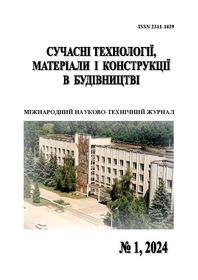THE INFLUENCE OF HEAT-CONDUCTIVE INCLUSIONS ON THE ENERGY EFFICIENCY OF THE EXTERNAL WALLS OF A DWELLING BUILDING WITH A MONOLITHIC FRAME
DOI:
https://doi.org/10.31649/2311-1429-2024-1-139-144Keywords:
energy efficiency, reduced heat transfer resistance, heat-conducting inclusion, modeling, temperature, exterior walls, monolithic frame, residential buildingAbstract
The influence of "cold bridges" on the reduced heat transfer resistance of wall enclosures, which characterizes their thermal insulation properties and energy efficiency, was studied. A nine-story monolithic frame residential building in the city of Lviv was considered. Wall enclosing structures 250 mm thick made of hollow ceramic blocks on a cement-sand mortar. The thermal insulation of the walls is made by the wet method with plates made of mineral wool 100 mm thick. Windows and transparent facade systems made of PVC profiles filled with double-glazed windows. The following heat-conducting inclusions were considered: mineral wool fastening dowels, window slopes, inter-floor and balcony ceilings, columns, corner joints. To determine the reduced heat transfer resistance, modeling of wall nodes was performed using the finite element method using the Agros2D software complex. As a result of the calculations, the temperature fields and heat flows for the corresponding nodes with "cold bridges" were obtained. Based on calculations of two-dimensional temperature fields of wall fragments, linear heat transfer coefficients for linear heat-conducting inclusions were calculated. The reduced heat transfer resistance for the external walls of the building in question was determined, taking into account the named "cold bridges". The results indicate a significant influence of these heat-conducting inclusions. The influence of each heat-conducting inclusion on the heat transfer coefficient was evaluated. It is concluded that heat transfer inclusions such as ceilings have the greatest impact on heat transfer for the house under study. The results of the research will be useful in the analysis of energy efficiency and the design of multi-story residential buildings with a monolithic frame.
References
DBN V.2.6-31:2021. Teplova izoliatsiia ta enerhoefektyvnist budivel : K.: Minrehion Ukrainy, 2022. 23 s.
DSTU 9191:2022. Teploizoliatsiia budivel. Metod vyboru teploizoliatsiinoho materialu dlia uteplennia budivel: K.: DP «UkrNDNTs», 2023. 60 s.
Agros Suite. http://www.agros2d.org/
ROCKWOOL. https://www.rockwool.com/ua/products-and-applications/products/ua-walls/frontrock-super-ua/.
Bauwer. https://bauwer.ua/products
Ratushniak H.S., Horiun O.Iu., Lialiuk A.O. Modeliuvannia teploperedavannia u vuzli prymykannia vikonnoho bloku do zovnishnoi stiny. Suchasni tekhnolohii, materialy i konstruktsii v budivnytstvi.Tom 29 № 2 (2020)), S.113-118. https://doi.org/10.31649/2311-1429-2020-2-113-118
Yurin O. Determination of optimal variant for insulation of the attic floor of the educational building / O. Yurin, A. Zyhun, A. Kliepko, Mahlinza Qiniso // Збірник наукових праць. Галузеве машинобудування, будівництво. Полтава : Нац. ун-т імені Юрія Кондратюка, 2021. Вип. 1 (56). С. 43–52. http://reposit.nupp.edu.ua/handle/PoltNTU/11339
Filonenko O.I. Considering the availability of cold bridges in the design of thermal insulation shell of sandwich panels element-by-element assembly / O.I. Filonenko, L.V. Hasenko, N.M. Mahas, N. Mammadov // Збірник наукових праць. Галузеве машинобудування, будівництво. – 2020. – № 2 (55). – С. 102-108. http://reposit.nupp.edu.ua/handle/PoltNTU/10184
Bodnar Yu., Bukhaniets D. Teplovtraty cherez stiny malopoverkhovykh zhytlovykh budynkiv z derevianym karkasom. Visnyk Lvivskoho natsionalnoho ahrarnoho universytetu. Lviv, 2019. № 20. S. 5-8. https://doi.org/10.31734/architecture2019.20.005
Pankevych O.D. Vplyv konstruktyvnykh rishen vuzlovykh ziednan (mists prymykannia konstruktsii) na enerhoefektyvnist budivli O.D. Pankevych, V.V. Mykolaienko, V.V. Pankevych, V.V. Nykolaenko. Suchasni tekhnolohii, materialy i konstruktsii v budivnytstvi. Tom 27 № 2 (2019), 20-29. https://doi.org/10.31649/2311-1429-2019-2-20-29
Jedidi, M.; Benjeddou, O. Effect of thermal bridges on the heat balance of buildings. IJSRCE 2018,2, 41–49. https://www.researchgate.net/publication/329488577_Effect_of_Thermal_Bridges_on_the_Heat_Balance_of_Buildings
Kotti, S.; Telia, D.; James, P.A.B. Quantifying thermal bridge effects and assessing retrofit solutions in a Greekresidential building. Procedia Environ. Sci. 2017,38, 306–313. https://doi.org/10.1016/j.proenv.2017.03.084
T. Theodosiou, K. Tsikaloudaki, D. Bikas Analysis of the Thermal Bridging Effect on Ventilated Facades/ Procedia Environmental Sciences Volume 38, 2017, Pages 397-404 https://doi.org/10.1016/j.proenv.2017.03.121
A. Zegeye and F. Tariku, Analysis of Thermal Bridges in Concrete and Cross-Laminated Timber (CLT) Constructions: A Numerical Study, in: DBMC 2023. URL https://www.scipedia.com/public/Zegeye_Tariku_2023a
Curto, D.; Franzitta, V.; Guercio, A.; Martorana, P., FEM Analysis: A Review of the Most Common Thermal Bridges and Their Mitigation, Energies 2022, 15(7), 2318; https://doi.org/10.3390/en15072318
Borelli, D., Cavalletti, P., Marchitto, A., & Schenone, C. (2020). A comprehensive study devoted to determining linear thermal bridges transmittance in existing buildings. Energy and Buildings, 110136. https://doi:10.1016/j.enbuild.2020.110136
Downloads
-
PDF (Українська)
Downloads: 78



